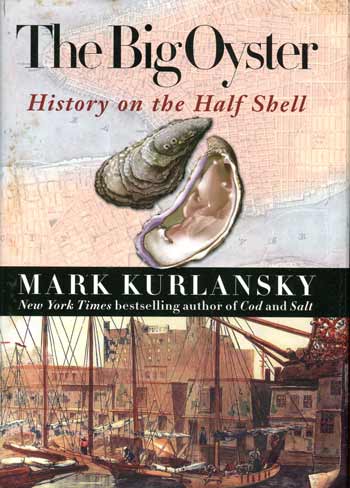B O O K R E V I E W
Being Eaten Alive!

The Big Oyster
History on the Half Shell
by Mark Kurlansky
307 pp., Ballentine Books
Oysters are making a comeback in the northeastern United States, re-emerging as a high end seafood. The oyster at one time was at the top of the summer seafood list for Native Americans of the Northeast. Not because they could one-up their neighbors with bragging rights to eating high-end seafood all summer long, but because it was so good nutritionally, good-tasting and easy to harvest.
When Europeans arrived it became for a time a low-end food in cities like New Amsterdam.
In some estuaries, the natural habitat of the American (Crassostrea virginicus) oyster, they were literally everywhere. Wading into the water could deliver foot-long oysters. One of the piles of oyster shells, the Whaleback middens, in Damariscotta, Maine, before it was excavated for chicken feed in the 1880s was 33 feet deep, 1650' long and between 1320' and 1650' wide. Across the Damariscotta River in Newcastle is the Glidden middens. It is now the largest in Maine and the largest north of Georgia. The Damariscotta River shell middens are not an exception. For 12,000 years Native Americans consumed large amounts of oyster along the east coast of North America. When Europeans arrived they continued the tradition.
The immense estuary that surrounds the lower Hudson River and New York City supplied the European colonists in the area with oysters for more than 300 years before the waste management practices and industrial development that Europeans brought with them eventually all but wiped out the oyster beds. These extraordinary filter-feeding animals, drastically reduced in numbers by the 1940s, managed to produce a few survivors, but they were by then too contaminated for human consumption.
The epic story of the American oyster is told in Mark Kurlansky’s. The Big Oyster: History on the Half Shell. Kurlansky is the author of 11 books including Cod: A Biography of the Fish That Changed the World; Salt: A World History and The Basque History of the World. Kurlansky based his history on the oyster in New York because of the enormous oyster resource that once surrounded the city. New York Harbor oysters were considered the best, even in Paris, as late as the 1930s. Kurlansky is also a New Yorker, which is how he was introduced to the story of the American oyster.
New York City is distant from Damariscotta in nearly every way. But the native oyster of the Hudson River estuary is basically the same as those that were in the Damariscotta River. The biological, gastronomic, economic, social and political place the oyster had in New York, and elsewhere, is what is interesting and important, both to New York and other areas where it may be making a comeback.
The Big Oyster begins with the pre-Columbian lower Hudson native Americans, their consumption of oysters and the area shell middens that evidence it. When the Dutch and English arrived they harvested and ate oysters, but added a commercial twist by selling them on the street and in oyster cellars and bars that proliferated with the growth of the city. America’s oldest restaurant, the 1826 Union Oyster House in Boston features the oldest and original oyster bar. Today varieties of cultivated oyster are served to customers seated at the semi-circular oyster bar, many of them grown in Maine.
Kurlansky has a fluid writing style rich in facts, anecdotes and history. For example, he writes, “According to the estimates of some biologists, New York Harbor contained fully half of the world’s oysters.” The scale of the New York oyster trade of the late 1800s may be difficult to comprehend today. It seemed it was everywhere on the waterfront. Today the American oyster, being brought back from near extinction, has been largely unknown to the diets of most Americans for a few generations. This makes the volume and demand for American oyster in the 1880s, in particular European demand, all the more amazing.
The oyster is the only animal humans in this part of the world eat while it is alive. Its health value for humans, the water it lives in and cleans, the provision of storm surge protection from oyster reefs, it’s value to local small scale growing operations and what it may do today to reduce ocean acidity all, it seems, make it a sea animal and food for the 21st century.
